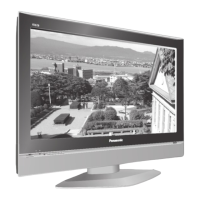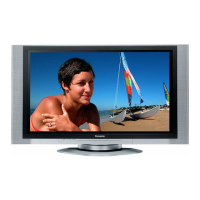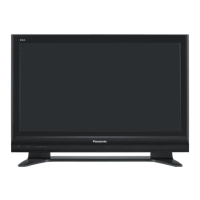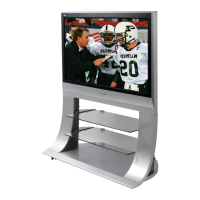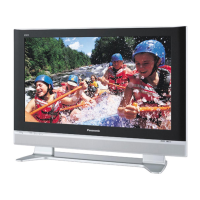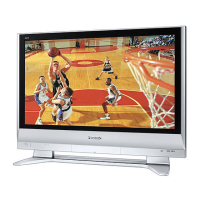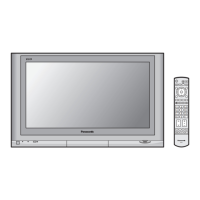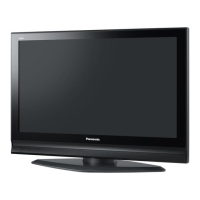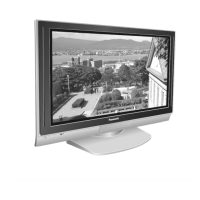
Do you have a question about the Panasonic TH-37PE30 and is the answer not in the manual?
Details fuse replacement, earthing, and plug safety for electrical protection.
Covers accessory compatibility, placement, and installation safety guidelines.
Provides warnings on ventilation, object insertion, power cord handling, and wet hands.
Actions for smoke, water ingress, and general usage safety warnings during operation.
Instructions for attaching ferrite cores to cables for noise reduction.
Steps for inserting batteries into the remote control for operation.
Instructions for accessing and securing the front and terminal covers.
Details on how to secure mains and other cables using clamps and bands.
Explains how to connect external devices like VCR/DVD and satellite receivers.
Guides on turning on the TV, auto setup process, and programme sorting.
Details how programme data is downloaded to recording devices via Q-Link.
Instructions for entering security code and personal details for owner identification.
How to access and navigate the DVB and Analogue TV Guides.
Explains functions of various buttons like Menu, Volume, Channel, Aspect, etc.
Describes the functions of the power switch, function select, and normalization store buttons.
Explains the use of MENU, Cursor, OK, and EXIT buttons for menu interaction.
Covers Viewing mode, Contrast, Brightness, Colour, Sharpness, and noise reduction.
Explains how to adjust the picture's tint and overall colour tone.
Covers Bass, Treble, Balance, and Headphone volume for audio customization.
Explains NICAM, Multi audio, Mode, and Ambience for enhanced audio playback.
Covers settings like Off timer, Power save, Side panel, and Volume correction.
Details Analogue/DVB tuning, Auto setup, and system configurations.
Explains Q-Link, AV outputs, Child Lock, and DVB tuner lock.
Explains how to add, delete, move, and rename programme channels.
Details Auto setup and Manual tuning procedures for station searching.
Covers resetting TV to factory settings and setting up the Owner ID.
Step-by-step guide to add or remove channels from the programme list.
Instructions on how to reorder programme channels.
How to change channel names and prevent access to specific channels.
Procedure for transferring programme information to an external recording device.
Explains the process of automatically tuning both analogue and digital channels.
Details manual tuning using the remote control and front panel buttons.
Instructions for resetting all tuning and control levels to factory defaults.
Guide to entering personal information and a security PIN for owner identification.
Checks signal quality and accesses the Common Interface Module.
Covers favourite channels, subtitles, and system software updates.
Details display timeout and screensaver activation for DVB mode.
Instructions for inserting, accessing, and navigating the Common Interface Module.
Select and manage favourite programme positions for quick access.
View programme details, upcoming shows, and switch channels using the information banner.
How analogue channel information is displayed and removed.
Instructions on how to check for and download new software for the DVB system.
Steps to program the TV for recording DVB programmes using an external device.
Options for setting daily/weekly recording schedules and handling timer overlaps.
Info on viewing/recording encrypted DVB programs using a CI module.
How to navigate categories, view programme details, and access the EPG.
Explains DIRECT TV RECORDING, preset downloads, and recording status.
Details auto power features, image view, and compatibility with other devices.
Explains automatic aspect ratio adjustment and WIDE identification signal.
Describes 16:9, 14:9, 4:3, and Just modes for picture display.
Explains Zoom1, Zoom2, and Zoom3 for letterbox and full-screen picture scaling.
Explains viewing two pictures simultaneously using PiP and PoP.
Details Picture-and-Picture mode for viewing two different sources side-by-side.
Covers Picture Mode, Contrast, Brightness, Sharpness, Tint, and Colour Balance.
Details advanced adjustments like W/B High/Low and Gamma.
Adjusts horizontal/vertical position, size, and clock phase for PC input.
Details signal adjustment and synchronization for PC input signals.
Covers displayable formats, folder structure, and notes on using SD/PC cards.
Important warnings and precautions for handling SD and PC cards.
Guide for inserting/removing SD/PC cards, including cautions.
Info on compatible card types, error messages, and important notes.
Adjustments for contrast, brightness, colour, sharpness, tint, and colour balance.
Configuring slide show settings like interval, sequence, repeat, and card selection.
How to view photos in multi-image, single-image, and slide show formats.
Describes functions like Standby, Play, Stop, FF, Rewind, Pause, and Record.
Explains List mode, FASTEXT mode, page selection, and display options.
Covers revealing text, coloured buttons, storing pages, and favourite recall.
How to view updates, news flashes, and access specific teletext pages.
Guide to accessing sub-pages and returning to the main teletext index.
Explains DVB teletext services, navigation, and software download.
How to use the Picture and Text feature to display program and teletext side-by-side.
Instructions on how to freeze the current image using the HOLD button.
Guide for connecting headphones and AV3 input devices.
Details connecting speakers via audio out and devices via Scart.
Instructions for connecting devices using component video inputs.
Guide for connecting a PC via the D-sub 15P terminal, including signal names and frequencies.
Lists common picture and sound symptoms and their suggested checks.
Addresses screen illumination, after-images, and the TV's sleep function.
Diagnoses problems related to no DVB channels, blocky interference, and aerial reception.
Detailed diagrams and pin descriptions for AV terminals.
Table listing compatible horizontal/vertical frequencies for PC input.
Details power consumption, panel dimensions, aspect ratio, and audio output.
Covers applicable signals, input/output terminals, and supplied accessories.
Contact numbers, website, and ordering information.
Information on recording model/serial numbers for warranty and purchase records.

